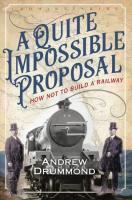A Quite Impossible Proposal: How not to Build a Railway
Andrew Drummond
Review by David SpavenMost Railscot viewers will be aware that efforts were made to build a railway from Garve to Ullapool in the Victorian era, but I suspect very few of us (certainly not me) knew that no fewer than five valiant attempts were made between 1890 and as late as 1945.
Andrew Drummond’s A Quite Impossible Proposal: How not to Build a Railway delves deep into the archives to reveal an astonishing story of establishment incompetence and indifference - and some west coast skulduggery - contriving to thwart the energy and enthusiasm of locals keen to share in the benefits which railways had brought to other Highland communities.
Most railway histories tend to treat their subject in a vacuum, with little discussion of the economic, political and social forces which spurred - or blocked, as in this case - railway development. Drummond makes no such mistake. He follows up his surrealistic 2004 novel, An Abridged History , on the imagined construction and operation of an Ullapool railway (and much, much more), with this graphic account of how a melting pot of rural poverty and agitation for land reform stirred up repeated attempts to drive a railway over 33 miles of sometimes tough terrain from Garve on the Strome Ferry / Kyle line to the Atlantic shores of Loch Broom.

Map: This is part of a map featured in Andrew Drummond's new history - 'A Quite Impossible Proposal' - of the many attempts to deliver a railway from Garve to Ullapool. The map was prepared by John Dixon, promoter of the rival Achnasheen to Aultbea railway, and it is a map with an agenda. Stornoway is clearly shown to be closer to Aultbea than to Ullapool. The fact that Ullapool has been misplaced about 3 miles eastwards of its actual location is significant. As is the highly exaggerated loop of the detour of the Ullapool railway at Braemore. Birlinn 07/09/2020
New markets for the fishing industry also lay at the heart of the quest for an Ullapool line. Government commissions on the subject came and went, but in 1889 an indefatigable Liberal MP undertook a fact-finding mission which concluded that a railway would solve the problem of getting fish quickly to the south: ‘The expectation, therefore, is that both Stornoway and Ullapool will immensely benefit by the opening up of the proposed communications, each developing the fishing industry under its more immediate sphere.’
The trouble was, Ullapool was not the only town on the north west coast which was after a railway. The Highland Railway had plans to extend their Dingwall-Strome Ferry line to Kyle, while other communities – notably Aultbea, Laxford and Lochinver – all had designs on the iron road. Despite much exertion and intrigue over so many years and an Act of Parliament for the Ullapool line approved in 1890, the final result was, of course, only a railway to Kyle.

Map: A map from Andrew Drummond's 'A Quite Impossible Proposal' shows part of an annotated Ordnance Survey sheet, prepared by Murdoch Paterson for submission with the plans for the Garve to Ullapool Railway in 1890. The route of the railway was marked in red ink - here shown in bold - clearly circling round the head of the glen at Braemore, into a tunnel, then heading off down to Loch Broom for Ullapool. Birlinn 07/09/2020
I asked Drummond what discovery most surprised him when writing the book:
Digging deep into the archive material was quite a revelation. I was impressed by the persistence and effort that local people put into promoting their own railway schemes; but even more astonished by the amount of effort that the Highland Railway Company put into making sure that none of these schemes succeeded. And finally I was appalled by the total lack of real understanding, interest or encouragement by any of several Secretaries for Scotland - and other government ministers - in Whitehall.
This is a serious subject, but Drummond has a light touch, with amusing anecdotes, colourful asides and wry commentaries – and I romped through the book in just two days. One of the delights of his tale is that ‘since we do not have the benefit of an actual railway carriage in which to sit back and enjoy the passing scenery’ the author treats us to a ‘virtual journey’ by way of Glascarnoch and the line’s 900ft summit near Loch Droma, followed by a ‘while-knuckle ride’ at 1 in 40 by Braemore and the Corrieshalloch Gorge before our train coasts down a gentler stretch of railway to the imagined terminus at Ullapool Pier. This would have been one of the great railway journeys.

Murdoch Paterson: Murdoch Paterson, chief engineer of the Highland Railway, was commissioned to draw up the Ullapool Railway plans (see image 74177) for submission to Parliament in 1890, as described in Andrew Drummond's A Quite Impossible Proposal: How Not to Build a Railway, published on 24th September. Given 'the amount of effort that the Highland Railway Company put into making sure that none of these [Ullapool Railway] schemes succeeded', Paterson's involvement was perhaps surprising! Follow link for a review of the book by David Spaven. Highland Railway Society //1896
Birlinn Press
ISBN: 978 1 91247 688 6

A Quite Impossible Proposal: How not to Build a Railway is published by Birlinn on 24th September. A paperback priced at £20, it extends to 308 pages, including comprehensive appendices, and features 33 photographs and maps. It can be purchased from all good bookshops and also direct from Birlinn (with free UK delivery):
https://birlinn.co.uk/product/a-quite-impossible-proposal/
Also available from Amazon
